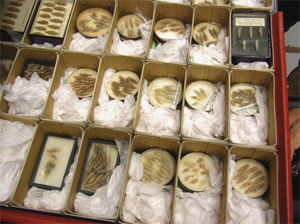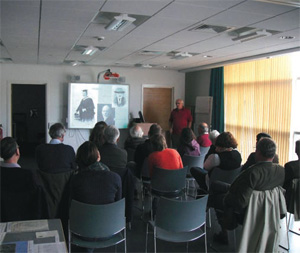|
The 19 individuals who attended this meeting at the Leeds Museum Discovery Centre included 12 members of the Society, a visiting group of seven students from the University of York, and our host, Clare Brown, Senior Curator Natural Sciences. The numbers don’t add up because Caitlin Potter is both a member of the Society and also currently studying at the University; she has been double-counted! Clare Brown started the morning session by introducing us to the Discovery Centre. This state-of-the-art building, Heritage Lottery funded and opened in July 2007, replaces the former Museum Resource Centre. It houses all the collections that are not currently part of public displays in the city’s museums, and provides office and research accommodation for staff. The area that holds the collections looks, at first sight, like a huge warehouse, but is in fact purpose-built for museum collections, e.g. it maintains a constant temperature of 16°C. Clare provided us with an impressive array of facts and figures, including that the animal, plant and geology holdings accumulated since the 1820s amount to more than 800 thousand specimens. The shell collection is the third largest in the UK (after London and Cardiff), and is used by researchers from around the world. Adrian Norris then outlined the history of the mollusc collection, which was one of the first specialities of the museum back in the 1820s, and includes a fair amount of type material. The start of the Leeds collection could be said to date back to the Conchological Society’s founding fathers, all of whom were based in Leeds: John W. Taylor, William Nelson, Henry Crowther and W. Dennison Roebuck. Since then there have been more than 150 donations, from quite small and specialised through to large collections of several thousand specimens. For a long time individual donations were kept separate, but in recent years, as the result of a large grant from the fund for Designated Collections, these were amalgamated into one large systematic collection. There were some interesting tales about conchologists, and the strange and difficult circumstances under which some collections were acquired. Most of the morning was spent in the main storage facility, and what an eye-opener it was! There were of course, thousands of shells, held in all manner of containers, many wrapped in tissue paper, the result of the recent move from the old Resource Centre. You could closely discuss with conchologists, for example, the difficult systemmatics of the species-rich assemblage of south-east European Clausiliidae; or you could range more widely through the collections: entomology, other natural history, through to every imaginable facet of our lives — furniture, fruit machines, clothing, a motor scooter … . One student, potentially interested in museum work, whispered to me that it was “A dream come true”! Back to our very comfortable meeting room where there was a rich display of archive material and artwork from the Leeds City Museum (much related to John W. Taylor), documents from the A.E. Ellis archives (Peter Topley), Barry Colville’s exhibits of some introduced species, British and European Pupillidae, and some examples of Granaria and Balea, and Adrian Norris’s display of a variety of early and modern books on Mollusca and (appropriately in the year of Evolution MegaLab) the Philips school chart on Cepaea by A.E. Ellis and his father. Over lunch the exhibitors said a few words of introduction to their material, and then we had plenty of time to browse at our leisure. The afternoon session was devoted to a presentation by Adrian Norris, “Climate Change: a Recorder’s Observations — Introductions and Alien Mollusca”. Adrian first covered the history of the recording and mapping of British and Irish non-marine molluscs, and he particularly emphasised (and showed) how different impressions can be gained of distribution and abundance depending on the scale of the mapping. He then asked what we mean by “introductions”, and by way of answering his own question, took us through the history of introductions in Roman times (7 species), post-Roman/Medieval (8 species), 18th century (4 species), 19th century (6 species), 20th century (17 species), and probably already four taxa in the 21st century (Arion occultus, Papillifera papillaris, Selenochlamys ysbryda and Granaria frumentum illyrica). (Note: in the 3 months following the meeting a fifth, and possibly a sixth, species have been brought to our attention; Adrian Norris, personal communication.) Their distributions are hard to understand, and it is unclear why some species are more widespread than others, and why some spread so much more rapidly than do others. Nevertheless, the fact that some introduced species can spread very rapidly indeed, and the accelerating frequency with which introductions are establishing, is notable, and the big question is whether climate change and warmer winters may be playing a part. Should we be concerned? — asked Adrian. He considered the possibility that there will be an introduction that turns out to be a real pest, or one that carries a disease agent. He noted that the USA spends millions of dollars attempting to eradicate molluscan introductions, whereas by comparison the UK seems hardly bothered. One thing, though, is clear: we need much more detailed and determined mapping because, with introductions, it is important to know where they are and how they are spreading. Adrian’s talk generated a lively discussion which concluded with the core need for there to be more people recording in the field, and that there is an especial need for generating interest in younger people and providing them with appropriate training. Given the presence of the students from York, this seemed to me to be a singularly appropriate note on which to finish the meeting. Also, as a recently retired university academic, I found it distinctly heartwarming to see, in this age of utilitarian approaches to education and knowledge, a group of young people simply revelling in their enjoyment of, and enthusiasm for, ecology, conservation and natural history, for its own sake and not in the pursuit of learning outcomes, exam marks, etc. Two of them did, however, comment to me that in their exams a couple of months later they were able to include in their answers relevant information gained from this meeting! We all enjoyed a most interesting and stimulating day in very congenial surroundings, for which we owe our thanks to Clare and the Discovery Centre. Members should note that the Discovery Centre welcomes, by appointment, visitors who wish to see, or carry out research on, its rich resources; please call 0113 214 1548. |
|
Regional Meeting at Leeds 7th November 2009
Issue
23
Page
10

 Figure 1:Attendees in the main storage facility (photo:Adrian Norris)
Figure 1:Attendees in the main storage facility (photo:Adrian Norris) Figure 2: detail from the illuminated presentation given to John W. Taylor by the Society on the occasion of his 70th birthday, on display at the meeting (Photo: Peter Topley)
Figure 2: detail from the illuminated presentation given to John W. Taylor by the Society on the occasion of his 70th birthday, on display at the meeting (Photo: Peter Topley) Figure 3: Members between two of the many sliding shelving units housing the mollusc collection (photo Terry Crawford)
Figure 3: Members between two of the many sliding shelving units housing the mollusc collection (photo Terry Crawford) Figure 4: Just a few of the Clausiliidae! (photo Terry Crawford)
Figure 4: Just a few of the Clausiliidae! (photo Terry Crawford) Figure 5: Adrian Norris delivering his presentation on “Climate Change: a Recorder’s Observations...” (Photo: Peter Topley)
Figure 5: Adrian Norris delivering his presentation on “Climate Change: a Recorder’s Observations...” (Photo: Peter Topley)